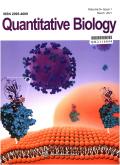菁和方英染料与SARS-CoV-2蛋白酶NSP3、NSP5和NSP12的分子对接
IF 1.4
4区 生物学
Q4 MATHEMATICAL & COMPUTATIONAL BIOLOGY
引用次数: 0
摘要
利用分子对接模型,研究了大量不同种类的花青素和方英染料与SARS-CoV-2冠状病毒蛋白酶的非共价相互作用。静电配体-蛋白质相互作用(库仑相互作用)对非共价配合物的稳定性起着重要作用。根据获得的数据,选择染料进行进一步的实际研究,目的是开发用于检测SARS-CoV-2的光谱荧光探针。此外,本文还认为中位取代的硫碳菁在冠状病毒的光灭活中具有广阔的应用前景。本文章由计算机程序翻译,如有差异,请以英文原文为准。
Molecular docking of cyanine and squarylium dyes with SARS-CoV-2 proteases NSP3, NSP5 and NSP12
Using molecular docking modeling, the noncovalent interaction of a large number of cyanine and squarylium dyes of various classes with SARS-CoV-2 coronavirus proteases has been studied. It has been found that electrostatic ligand-protein interactions (Coulomb interactions) can play an important role in the stability of noncovalent complexes. Based on the data obtained, the selection of dyes for further practical research has been carried out with the aim of developing spectral-fluorescent probes for detection of SARS-CoV-2. In addition, it is concluded that mesosubstituted thiacarbocyanines may be promising for use in photoinactivation of the coronavirus.
求助全文
通过发布文献求助,成功后即可免费获取论文全文。
去求助
来源期刊

Quantitative Biology
MATHEMATICAL & COMPUTATIONAL BIOLOGY-
CiteScore
5.00
自引率
3.20%
发文量
264
期刊介绍:
Quantitative Biology is an interdisciplinary journal that focuses on original research that uses quantitative approaches and technologies to analyze and integrate biological systems, construct and model engineered life systems, and gain a deeper understanding of the life sciences. It aims to provide a platform for not only the analysis but also the integration and construction of biological systems. It is a quarterly journal seeking to provide an inter- and multi-disciplinary forum for a broad blend of peer-reviewed academic papers in order to promote rapid communication and exchange between scientists in the East and the West. The content of Quantitative Biology will mainly focus on the two broad and related areas: ·bioinformatics and computational biology, which focuses on dealing with information technologies and computational methodologies that can efficiently and accurately manipulate –omics data and transform molecular information into biological knowledge. ·systems and synthetic biology, which focuses on complex interactions in biological systems and the emergent functional properties, and on the design and construction of new biological functions and systems. Its goal is to reflect the significant advances made in quantitatively investigating and modeling both natural and engineered life systems at the molecular and higher levels. The journal particularly encourages original papers that link novel theory with cutting-edge experiments, especially in the newly emerging and multi-disciplinary areas of research. The journal also welcomes high-quality reviews and perspective articles.
 求助内容:
求助内容: 应助结果提醒方式:
应助结果提醒方式:


